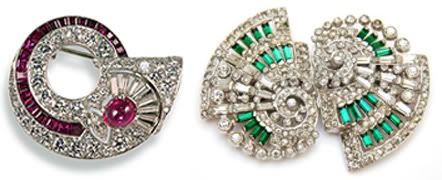
I love pins! They come in and out of style, but I have kept all of mine and inherited some from my family and the Guy's family. Pins tell such a story about a person.
Madeleine Albright certainly felt that way. In 1997, she was named the first female Secretary of State and became the highest ranking woman in the history of the U.S. government. While serving she became known for wearing brooches that purposefully conveyed her views about the current situation. "I found that jewelry had become part of my personal diplomatic arsenal," Secretary Albright has said. "While President George H.W. Bush had been known for saying 'Read my lips,' I began urging colleagues and reporters to 'Read my pins.'"
Later Secretary Albright wrote a book, Read My Pins: Stories from a Diplomat's Jewel Box. It's a fascinating book that accompanied a museum exhibit of her pins. I have not seen the exhibit, but am planning to go when it is in Atlanta this fall.
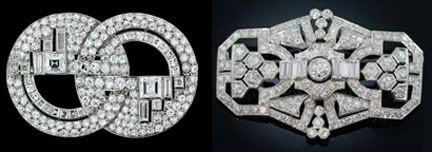
Pins have not always been part of a lady's wardrobe. In 1540, Henry VIII married Catherine Howard. She introduced decorative pins into England from France. Pins were very expensive at first, and a separate sum for this luxury was granted to ladies by their husbands and fathers. These funds became known as pin money. It also became common for women to be left pin money in wills, even though most property at that time had to be under the control of men. This term doesn't seem to be a terribly popular expression at the moment, but I remember my grandmothers and great-grandmother using it regularly.
The earliest written usage was in the 16th century in The Testamenta Eboracensia - A Selection of Wills from the Registry at York, 1542:
"I give my said doughter Margarett my lease of the parsonadge of Kirkdall Churche.. to by her pynnes withal."
The first explicit mention of the term pin money is by John Dryden in 1690 in the comedy Amphitryon:
"There's Pin-money, and Ali-money, and Seperate maintenance."
One of the most interesting sources of pin money is the Henry G. Freeman Jr. Pin Money Fund. Henry G. Freeman was a Philadelphia businessman. In 1912 his will established this fund. Even more interesting is the recipient of the Pin Money Fund: the First Lady of the United States. Freeman believed that our president was paid a "miserable pittance" ($75,000 at that time), and that this would be a way of increasing presidential income while avoiding the appearance of the controversy of political gifts.
The will instituted an annuity to be paid "to the lady termed the first lady in the land; that is, the President of the United States [sic] wife, or anyone representing the president as such, should he not be married or should she die during his administration." It also specified that the money be for the first lady's "own and absolute use" and the payments "shall continue in force as long as this glorious government exists."
The trust set up by the will would provide the yearly sum of $12,000, but the distribution of the money would not begin until Mr. Freeman’s last heir had passed away. The Pin Money Fund became active in 1989. Barbara Bush was the first First Lady to benefit from it. She gave most of the money to charity, but used some of it to do something nice for her grandchildren. Hilary Clinton and Laura Bush have donated the money to charity. As the money is taxable, that gave them some kind of write-off on their tax bill.
Over the years pin money has come to refer to money for incidental expenses. If a person works merely to buy the "little extras", it is said they are working for pin money. One day every week my great-grandmother baked bread and sold it to the local grocer and to some of the ladies in town. Everyone thought Ms Louise made the very best bread (SHE DID!!!) and always felt lucky to be able to buy some from her. She kept the money she made from the bread in a special little purse and referred to that money as her pin money.
Back in the 1950s and 1960s a number of potteries that made novelty items made Pin Money Banks. Most of these are in the shape of a purse, labelled, and are decorated with such things as flowers, rhinestones, and gold or silver paint. And with another play on words, some of the banks are shaped like bowling ball bags or bowling pins. A couple of years ago I started a little collection of Pin Money Banks. My personal preference is for the more dainty ones, rather than the ones associated with bowling. I don't have a lot of them, but I think they are cute. Here is a picture of my collection. And this is where I am getting my pink for Pink Saturday!.
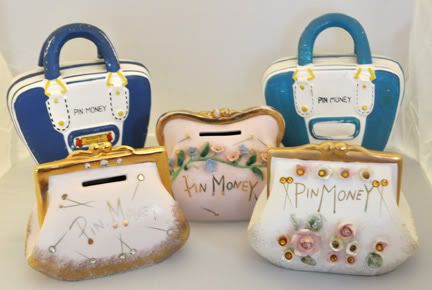
And maybe I should start using them so that I'll have some pin money for some of those lovely art deco pins! Happy Pink Saturday!

namasté,


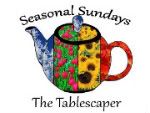

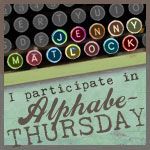
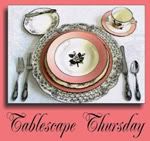
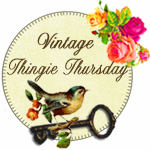
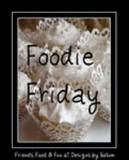






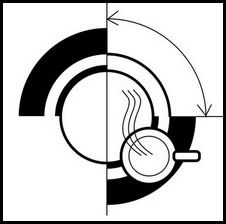

 Alabama Time
Alabama Time Paris Time
Paris Time Venice Time
Venice Time










19 comments:
Ah, Becky. I love this post!!! And, I love your collection.
I have a small collection of pins, and I have mine displayed on pillows. I call them my pin pillows.
Happy Pink Saturday.
Fabulous post, Becky!
I love pins too. I have several I've had for quite awhile. Still wear them now and then.
Happy Pink Saturday!
Your collection is wonderful. I love those also, Happy Pink Saturday, Char
Great post Becky....I inherited a couple of 'pin' money banks from my Mom. I adore them, they bring me memories. Love your collection and the pins.
What a fascinating piece! I have heard the term 'pin money' for as long as I can remember, although I do not recall my mother using it. I had always thought of it as a bit of money a woman could attach to the inside of her dress or blouse with a pin for a little emergency. Clearly, I should have read up on it. Thanks for the stories and picture.
That was so interesting. Thanks for sharing your collection with me.
Such wonderful treasures you have.. I too love pins and have some that I treasure that my past husband bought me.. he would often look in pawn shops while we were in Florida for a rare find. I love the gold heart he found with red rubies.
This is such a great post, Becky! It was eye candy and informative.. That was fun! Do you live in Atlanta? I used to live in Lawrenceville years ago and LOVED it!
Happy Pink Saturday!
Becky, this is very interesting, I never knew about this, though I know the phrase. Thank you for sharing this, I love when I learn something new. Love your collection, too.
Happy PS.
Gail
Happy Pink Saturday Becky Sweetie...
What a beautiful share. I loved the history about the pins. I didn't know quite a bit of that history and it was really interesting. I loved the pinkish red one most of all. I love red and pink. They are my favorites in color.
Now I have never seen these pin money banks, but I have to tell you they are just the cutest things I have ever seen. I loved the white one with the little pink flowers. That was so cute. Thank you for sharing with me.
I am Country Wings in Phoenix, your newest follower. I love your blog, and I can't wait to see what you share next. Please stop by and say hello. I would love to have you follow as well. I love meeting new friends and sharing along the way.
Many country hugs, Sherry
I almost bought one of those Pin Money banks last summer, from an estate sale, and of course now I really regret leaving it behind! What a sweet little collection you have, and the history on pins was fun to read. Thanks so much for sharing it!
Happy Pink Saturday!
Carol
What a neat post! I saw a Pin Money bank while I was out antiquing yesterday...now I wish I would have picked it up! :) You're right about pins "coming and going"...I took a class on Viking history this fall and learned that many pins/brooches have been found dating from that time period. Often they were made from coins of other lands. How fun!
HaPpY pInK sAtUrDaY!
Sarah
Wow you've done your homework and love art deco era and your jewels!
Happy Pink Saturday
Howdy Becky
Thank you for the awesome post !
Happy Pink Saturday to you .
I do love pins and grew up with the phrase Pin Money thanks to my
great Grandmother as well as my granny :)
I did not know very much of the fantastic history that you shared with us so I am very thankful that I came by your blog to visit today.
I am now a follower so I'll be back again and hope that you'll drop by to visit my neck of the woods sometime the door is open so come on in :)
Hugs from Texas
Until next time
Happy Trails
what a great post! i love the pin moneies! such a cutie! would love to have at least one! Happy PS!
What an interesting post! I never thought about the history of pins. I love them and have several but I often feel at odds wearing them because for some reason I just don't see them worn alot. I think that's really sad because they are so pretty and really dress up an outfit! Thanks so much for sharing, have a wonderful weekend and have a Happy Pink Saturday!
-April
What a great post! So interesting and very pretty too!
Hugs,
Debbie
Becky....I absolutle every word and picture of your post this week. I am 71, and my mother - from Atlanta -lived to be in her 90's. She always had her "pin money"stashed for a rainynday. She also told me to keep my own secret stash or bank account so I would always have my OWN money to spend as I wanted. I never thought anything about the term until I read and studied your post. Now you ate going to have me searching for one of those precious purses. Thank you so much for taking the time to write all of your story for us. Genie
Hi Becky - on another note, Roman women wore pins called " fibulae" to gather the fabric of their shoulders on their "one- size- fits- all" dresses (stolae). Some were worked gold while others were fancier with semi- precious or precious stones.
Post a Comment